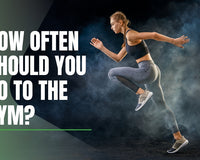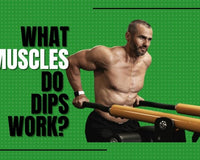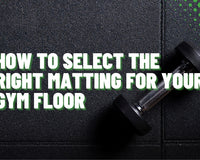If you see someone at the gym laying on the ground under a smith machine and thrusting their hips up into the air, they're likely doing a hip thrust. Hip thrusts can also be done using barbells, dumbbells, and even special hip thrust machines.
Whatever method you use to perform hip thrusts, it's a valuable exercise, particularly for your glutes.
In terms of building your glutes, the hip thrust is absolutely one of the best exercises out there, but one thing that many people overlook is foot placement.
The way you place your feet when doing hip thrusts plays a big role in the muscles that you target. Placing your feet properly also helps avoid injuries and gives you those toned glutes you're looking for.
The fact of the matter is that small details like foot placement really matter when doing hip thrusts. The distance between your feet, the angle of your feet, and even your overall elevation can all change how your body, and your glutes, react to this exercise.
Keep reading if you want to get the most out of your hip thrust exercises, because we'll talk about the mechanics behind the exercise, as well as how you can optimize glute growth through proper foot placement.
The Benefits of Hip Thrusts

Something you might be wondering is what the benefits of doing hip thrusts are. Well, first and foremost, it's a great strength exercise for your lower body.
Hip thrusts primarily target your hamstrings and quadriceps, as well as your gluteus maximus, which happens to be the largest muscle in your rear end.
Of course, by constantly engaging these muscles, not only are you making them stronger, more resilient, and able to lift more, but you're also toning them and achieving that shredded look you've always dreamed of.
Past aesthetics and strength, there's also the simple fact that stronger glute muscles help you improve your overall athletic performance, because not only are your legs stronger, but those stronger glutes also allow you to run faster and jump higher.
Even something as simple as your posture can benefit from doing hip thrusts. By including hip thrusts in your leg day routine, you can strengthen your lower body, improve your balance, run faster, jump higher, and most important of all, look great in those bike shorts.
Why Foot Placement Matters When Doing Hip Thrusts
You might think that as long as you do hip thrusts, you're doing the best that you can do.
Unfortunately, this is not really the case, because how you place your feet on a hip thrust machine, or on the ground if you aren't using a hip thrust machine, makes a big difference in terms of the overall effectiveness of the exercise, as well as the muscles that you activate.
Generally speaking, the starting position for a hip thrust will have your feet at shoulder width with your knees bent at around 90°.
However, by adjusting your foot placement, you can increase or decrease the amount of pressure that you put on certain parts of your hamstrings, glutes, and even your quadriceps.
The right position helps ensure that you're using the right muscles and also prevents any kind of lower back strain from occurring.
Proper Form and Technique for Hip Thrusts

If you're going to do hip thrusts, one of the most important things you have to do is maintain proper form.
Remember, every exercise starts with form, and you're always better off lifting a light weight with good form than you are lifting a heavy weight with bad form. Let's get to it and go over some essential tips on how to do hip thrusts the right way.
In terms of overall form, you're going to rest your upper back against a bench. Make sure that your shoulder blades are firmly positioned to keep you stable throughout the exercise.
You'll also want to make sure that the pad of the machine is resting just below your hip bones, with your feet flat on the ground, and roughly hip horse shoulder width apart.
As you press forward with your hips, make sure to engage your core. Squeeze your glutes as you drive your heels to thrust your hips forward, and make sure that your knees form a 90° angle once you're at the top of the movement.
Now, as we mentioned above, your foot placement makes a big difference in terms of which muscles you activate the most, so let's move on and talk about the different foot placements for activating different muscles.
Proper Hip Thrust Foot Placement
Whether you're using a hip thrust machine, a glute machine, or a smith machine, make sure that your feet are positioned at roughly hip width.
You'll also want to make sure that your knees align with your toes, and that your feet are flat against the ground. This is a rule of thumb no matter which part of your legs you plan on targeting the most, as we'll see below.
Best Hip Thrust Foot Placement for Glutes

First and foremost, if you're looking to target your glutes, then the number one thing you can do is position your feet wider apart. The wider apart your feet are, the more intensely you'll target both your hamstrings and your glutes.
At the same time, you'll want to turn your toes outwards. Instead of having your toes facing inwards or your feet straight up and down, align your feet so that your heels point inwards and your toes point outwards.
This is the ideal foot placement if you're looking to isolate the gluteus maximus. By using this foot position, you can target these muscles without necessarily adding more weight to the equation, therefore providing you with a safe and reliable way to get stronger glutes.
Something else to note about this particular foot placement is that it minimizes the activation of your quadriceps, allowing you to focus solely on your glutes.
Of course, your quadriceps will still be activated during this motion, but much less due to the wide stance of your feet combined with your toes being pointed outwards.
Related Post: Top 7 Dumbbell Leg Exercises
Best Hip Thrust Foot Placement for Quadriceps

Whereas the above foot position was ideal for engaging your glutes, now we want to engage your quadriceps the most. To engage your quadriceps over all other muscles when doing hip thrusts, bring your feet closer together.
By bringing your feet closer together, you increase your overall range of motion during the exercise, which helps to activate the quads even more.
To ensure that you maintain proper form and avoid injury, keep your toes and knees aligned during this exercise. As you lift your hips upwards, concentrate on the tension that you're putting in your quadriceps, and engage them as much as possible.
Furthermore, if you're looking to grow your quadriceps, you'll also benefit from turning your toes inwards. Whereas turning your toes outwards is great for targeting your glutes and hamstrings, turning your toes inwards is fantastic for targeting your quadriceps more than anything else.
Related Post: Choose between KAS Glute Bright or Hip Thrust?
Best Foot Placement for Various Hip Thrust Variations

Something to keep in mind is that you might reach a plateau when doing hip thrusts. If you're looking for some alternatives, doing squats, glute bridges, and glute kickbacks are all options.
What's interesting to note is that each of these exercises features a slightly different foot position and therefore, unique muscle activation. This helps you align your personal weight training goals with your workouts.
For example, if you are doing a single-leg hip thrust, place your feet closer to your glutes, as this will enhance glute activation due to increased hip flexion.
On the other hand, if you're doing banded hip thrusts, which are characterised by wrapping a resistance band around your knees, it helps to modify muscle activation through the encouragement of external rotation, therefore increasing glute activation.
Also worth noting is that if you're doing a regular barbell hip thrust, the further you put your feet from your body, the more the focus will be on your hamstrings. However, the closer you put your feet to your body, the more the focus will be on your glutes.
Hip Thrust Foot Placement Mistakes to Avoid
Before we wrap things up, there are some common mistakes when doing hip thrusts that you need to avoid.
-
Avoid putting your feet too far back or forward, because it will prevent you from getting a full hip extension.
-
Try to avoid having your feet far too narrow or too wide, because this can strain your knees, and also fail to activate the muscles you want to focus on the most.
-
At the same time, avoid having your feet turned too far inward or outward, as this can cause knee injuries.
-
Never lift your heels off the ground, because this limits your range of motion and reduces your overall stability.
Related Post: Hip Thrust Vs Glute Bridge - What's the Difference?
Final Thoughts
The bottom line is that if you want to activate your glutes the most, spread your feet further apart and turn your toes outwards, and if you want to target your quadriceps the most, put your feet a little closer together and turn your toes inwards.





